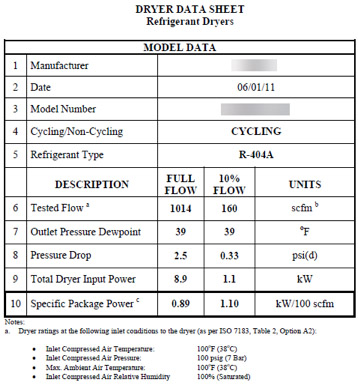 When you are in the market for a refrigerated compressed air dryer, it is wise to do some research to find the most economical choice. Air dryers last for many years and can consume a significant amount of energy through the life of the equipment. Choosing a low cost unit that consumes more power can end up costing more in the long run.
When you are in the market for a refrigerated compressed air dryer, it is wise to do some research to find the most economical choice. Air dryers last for many years and can consume a significant amount of energy through the life of the equipment. Choosing a low cost unit that consumes more power can end up costing more in the long run.
Refrigerated dryers, as the name implies, use a refrigerating circuit to cool the compressed air to remove moisture. This produces compressed air with dew points of about 2° C (35° F). The two basic types of refrigerated dryers are cycling and non-cycling.
Non-cycling dryers use a type of control that maintains the internal dryer temperatures to provide cooling and drying action but does not act to achieve very much of an energy turn-down through the full range of the air dryer loading. Basically, this type of dryer consumes almost the same energy whether or not there is full flow or low flow. If this dryer is used on systems that run at partial loads, some significant amount of energy is wasted.
Cycling dryers, on the other hand, cycle the refrigeration on or off like your refrigerator at home, and in doing so have an energy turn-down that is directly related to the dryer moisture loading. If the dryer is lightly loaded, its energy consumption will be reduced depending on the energy turn down characteristics of the dryer.
Many manufacturers are members of the Compressed Air and Gas Institute and, as such, must publish CAGI data sheets for a certain size range of air dryers. You can use the sheets to figure out the energy savings one dryer compared to another.
For example, a 1,000 cfm non cycling dryer might consume 7.3 kW at an average loading of 40%, costing about $6,400 per year to operate at 10 cents per kWh. A similar sized cycling dryer might consume about 4.2 kW under the same loading, costing only about $3,680 per year. Over a 15 year dryer life, this difference might total $41,000 in electricity costs. This should be compared with the purchase price for the two units to make a wise comparison.
Of course, if your dryer always runs at full load, then the calculations would be different and might even show the cycling dryer would consume more power, so loading conditions should always be taken into account.
Another thing you should look at is the dryer pressure differential, the range of makes and models may have different pressure drops—this can affect the operation of the air compressors. A dryer with a 5-psid pressure differential may cause the compressors to consume more energy due to more frequent compressor cycles and higher discharge pressures, which makes the air compressors consume more energy.
Also, if you are for saving the ozone layer, the type of refrigerant may be important to you. Some older dryers, or air dryers produced in other countries, may still be using R-22 refrigerant. Most newer designs produced in developed nations use more ozone-friendly refrigerants.
Filed Under: Fluid Power Basics, Pneumatic Tips